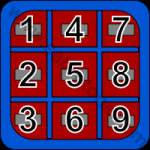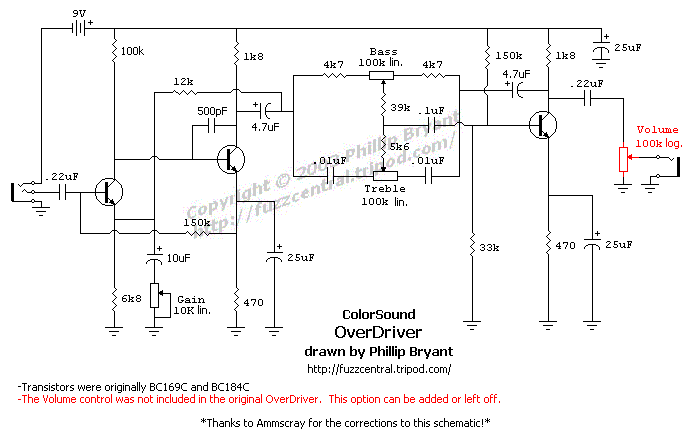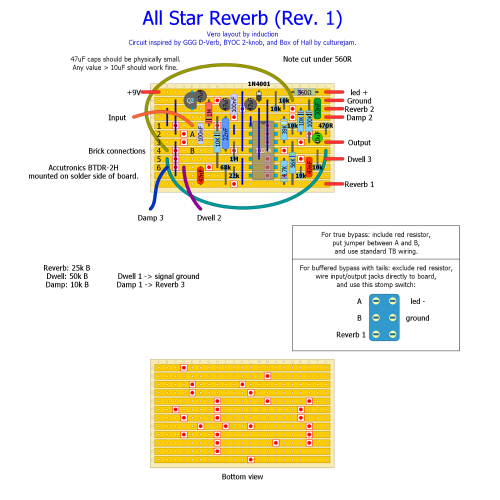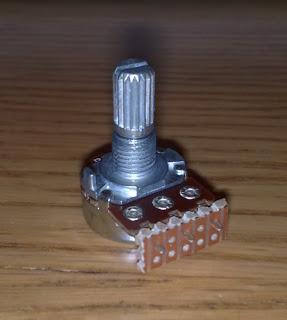Newbie has switch dilemma, due to bad instructions.. Help!
12










12
Newbie has switch dilemma, due to bad instructions.. Help!
|
Hi, folks, first timer, here.
I didn't even realize this DIY pedal thing was a thing until, when I looked at an issue of Tone Report Weekly and Nick Kula had a DIY guide for a Colorsound Overdriver. Cool, I thought, I can do this, I have zero experience about electronics, but now I can learn. So, I get the pedal together, and when I get to the bottom, I realize his instructions were incomplete, in that he just says "wire up the input and output to their proper spot on the switch". Problem is, he doesn't provide a switch diagram like he usually does, and the last photo he shows, doesn't show the complete wiring to the switch, AND he has the switch in the photo oriented differently than he describes it in the instructions. So, here I am, wanting to finish this pedal...I've contacted Tone Report for help, it's been a week now, and I still haven't heard anything, and, looking around on the net, not really quite having this down yet, I can't seem to figure out what to do. What a mess! I guess I should have looked at the directions before buying all the parts. I'm wondering, could anyone here help me with how to wire up the switch? The instructions are on page 24 of the issue at this link: https://www.joomag.com/magazine/tone-report-weekly-issue-107/0722722001450906625 Thanks, so much. |
|
Administrator
|
hey man welcome. i read that article too and found it lacking for someone wanting to get into building, IMHO. in any event to answer you question what you need is what's called the offboard wiring. on the main part of site there's a tab that says "OFFBOARD," for ease clink here.
the orientation of the switching isn't that big a deal as long as all your hookups are in the right places. he shows the switch in sideways. which is causing your confusion. |
Re: Newbie has switch dilemma, due to bad instructions.. Help!
|
So, the drawing you refer to is what his should look like if his switch was rotated 90 degrees counterclockwise?
Also, where does the anti-pop resistor tie into what you posted? Is that something I can put in to all my builds? Not quite there yet, but I think I will be. THanks. |
Re: Newbie has switch dilemma, due to bad instructions.. Help!
|
One other thing he screwed up that I couldn't figure out... for the wiring to the bass pot, he has bass 3, bass 2 and bass 3....shouldn't one of those be bass 1? Which one?
Seems like I didn't pick the best one for a first project, huh? He even had a typo for the number of electrolytic 22 uf caps. |
|
Administrator
|
yes, if the switch in the tone report article was rotated 90 degrees it will look like the one in the offboard wiring diagram. when you look at the lugs of any switch you want them to be horizontal in order to identify their proper numbers. here's a 3pdt switch like commonly used as your on/off stomp switch.

in 99% of the layouts here the anti-pop resistor is included in the layout. it's just a 1M resistor that connects the input on the board to ground. if the layout you're working with does not have one, just connect a 1M resistor from the input wire that goes to the board to one of the ground lugs on the switch. now as far the wiring mistakes. you always want to have the schematic for a pedal if you can when building, especially at the beginning. this will help you identify if parts or wiring is wrong, and allow you to trace the circuit. with that being said, lets take a look at the schematic  you'll notice in the schematic the 25uF caps are 25uF, but while you can still get that value 22uF is more common and can easily be used in this effect without causing any major changes. as far as the wiring of the bass pot. if you look at the schematic you'll notice Bass 3 is connected to a 4.7k resistor that connects with one leg of the 4.7uF cap, and 10nF cap that goes to treble 3. Bass 1 on the other hand connects to a 4.7k resistor 4.7uF cap, and 10nF cap that goes to the Collector (C) of Q3. so if we look at the layout in the tonereport article the wire labeled "Bass 3" that is under the wire labeled "Treble 1." not sure if you built the board yet or not, but if you haven't and you're dead set on building this as your first pedal i would suggest using the layout on the main site, here. it's smaller, cleaner, and i know for sure it works. i would suggest however that to start off building something a little simpler as a first pedal, and what i mean by that is something that has a few less components, and less offboard wiring (less pots). it will help take away a lot of frustration in a first build and hopefully keep you wanting to build, rather then getting pissed and giving up. |
|
In reply to this post by lordradish
One of the biggest problems that people have when discussing things online, but also in general, is that they assume that what is common knowledge to them is common knowledge to everyone. So they start leaving out things that they assume people already know. Or that accursed overuse of acronyms. The golden rule should be that not everybody will be as knowledgeable as you and realize that most of what you think is hot shit means nothing to most of us.
|
Re: Newbie has switch dilemma, due to bad instructions.. Help!
|
Wow, thanks, folks. Y'all are rather kind to noobs, here, some places would have just called me out in some way, much appreciated. I have the circuit all put together already, so I'm committed. I already bought the parts for the 75 Mystery Muff in Tone Report 112, but after seeing what a mess this one was, I'm not so sure I want to do any more of those (had I known about this site, I wouldn't have bothered in the first place). I will let you know how it goes.
Two last questions, if I may. Non-polarized caps... I read somewhere that it doesn't matter which way you orient them, yet most of the diagrams I see show the elec. caps with the negative on one side. Does that mean all of my caps should be polarized? Second, I think I looked through everything on the site, is there something that shows a key for all of the symbols on the layouts so I know what everything is that I need to order? Thanks again! |
Re: Newbie has switch dilemma, due to bad instructions.. Help!
|
Hey lad
1. Non-polarised caps (ceramic, mylar, poly box film etc) do not have polarity meaning yes, they can be orientated any way round. Electrolytic and tantalums are polarised meaning they must be inserted exactly as the layout shows...usually represented with a stripe on one side denoting the negative (cathode) leg. So when you see a cap with a stripe, it means electro or tant so take care on its orientation. 2. There isn't really a legend here for the symbols as we all tend to place the values on the component layouts rather than using names like C1, R14 etc. We all tend to stick to a certain convention about this... 1pF to 1nF (shown as orange ovals) would typically be ceramic capacitors due to they're small size. Non polar 1nF to 1uF (shown as red ovals/yellow or green boxes) would be poly box film caps/greenies etc. Again non polar 1uF and up (shown as circles with a stripe on one side) would be electrolytic or tantalum caps. These are generally used for power filtering, coupling etc. They must be orientated as shown due to them having polarity. It's important to note however that these are just guidelines we all tend to follow, not rules. There are certain values of specific caps that differ greatly in terms of physical size. A prime example will be 100nF. Greenies in this value are MASSIVE and sometimes difficult to place on a board. So when I see this value in a tight space (look at some of the delays) I'll usually use a 100nF ceramic cap instead. They are so much smaller and can span single rows much easier than other caps. So ultimately...as you'll read here time and time again...it's the value that's important, not the material. I hope this is enough to get you started. You made a good point about not finding a legend and is probably something we all overlooked. If no one has already started on one I'll make one up over the next few days and post it in Beginner's Corner on the forum. All the best and welcome Ciaran |
Re: Newbie has switch dilemma, due to bad instructions.. Help!
|
Thanks, Ciaran!
|
|
Administrator
|
In reply to this post by Ciaran Haslett
Just to add a little bit about caps. There's a lot out there says you bed "X" brand or "X" type (mica, tantalum, POI, etc.) cap to get a certain sound out or that they make a pedal sound better. Don't fall into that. If the value is right, and it can handle the needed voltage you'll be good to go. The only exception is the traditional ceramic caps of high values will tend to add notice and are microphonic, so use them for anything under 1nF.
With caps there are a few standards: <1nF ceramic caps 1nF --> 1uF poly/mylar/box/multilayer ceramics (which can be found from 1pF up to 10nF) >1uF electrolytic/tantalum Personally my suggestion for caps is to use the smallest size part for a given value that is above the voltage you're going to run the pedal. Example, all my electrolytics are either 25V, 35V, or 50V because since I'm not going to run any pedal with that much voltage I don't have to worry about blowing them up, and they still have a relatively small footprint. For my poly caps I use panasonic ecq-v 63V, I think it's the v but could be wrong. I use them not just cause of the quality, and voltage rating, but because they take up very little space. I also have and use multilayer ceramics, but I save them for really tight spaces, cause they can be a godsend in some pedals when you have barely enough space for even one of those to fit in. I'll take a pic of all the panasonics, greenies, box, and multilayer so you can see the difference when I get home from work. It's really crazy to be honest when you see them next to each other. Also, always happy to help. We all had to start at the beginning and it's a hell of a lot easier when you get some guidance. Otherwise how are you going to learn? |
Re: Newbie has switch dilemma, due to bad instructions.. Help!
|
Y'all are awesome. One more question, then, about reverbs... I know that the reverbs tend to be a bit more on the difficult side, but I really want to take a stab at that Death By Audio one. I was looking at some of the layouts, they all use that reverb chip in one way or another. I see where, on the layouts, it says what pins go where for the reverb chip... not having the part in front of me, do these verb chips basically sit on top of the board, with the pins long enough to solder at the various points on the board?
|
|
In reply to this post by lordradish
Muffs are fun.  Although to be fair I had problems with with my first Muff builds and still haven't managed to get my Pink Flesh to work right. Still, Muffs are one of my favorite builds on vero. I've built so many of them I learned how to figure out how to troubleshoot faulty builds and reading schematics because of them. I see that in issue 112 they finally realized they had to include how to wire a 3PDT switch as well. So you were probably not the only one who had problems with that. Now if only they learn that if you're going to build a pedal on vero you also need to include the schematic on which it is based. Because that makes troubleshooting SO MUCH more helpful. Then again, that's a lesson that's not been always being learned on this site as well. That mystery muff schematic looks fun though. I'm going to build it. One day. I'm not going to use the vero layout from the magazine though, I prefer |v|ark's classic symmetric Muff layout, best Muff layout EVER! http://3.bp.blogspot.com/-SZzinuajzrY/UR_Lu4KAtiI/AAAAAAAAE6E/rPAQ4ox_Wyc/s1600/EHX+73+Rams+Head+Big+Muff.png Just an easy substitution of the right values. Easy thanks to the schematic. Found here: http://www.bigmuffpage.com/images/schematics/10_15_75_Big_Muff%20Schematic_sm.jpg And let us not forget to add the scooped/flat/boosted mids switch. Which should be mandatory on all Muffs. And since this build uses a lot of 1uf caps I'd substitute the 1uf electrolytics caps for 1uf non-polarized caps. Because you can. Becaus there would be no hassle with +/- orientation. Because film caps tend to last for longer then electrolytics. And because mmonolytic ceramic capacitors are also smaller. For transistors I'd probably use BC239's, which if memories serve me right were what Electro Harmonix was using a lot around that time. |
|
In reply to this post by lordradish
On pcb boards that are profesionally fabricated you can solder the reverb bricks, usually from Belton, straight to the board. On a vero layout, unless it is specifically said that you can do that, you'd have to run wires to each corresponding pin on the Belton brick. http://www.banzaimusic.com/Accutronics-Digi-Log-BTDR-2V-Long.html If you open that link you can see a picture of a Belton reverb brick module. Pro fabbed board can have a neat row of corresponding holes where you can solder such a beast onto, with vero its usually impossible to create something that is similar. So wires it will be. Here's a little trick I learned soldering wires unto straight pins. If you melt some solder onto both the pin and the stripped part of the wire separately, and then put them together and apply heat from the soldering iron the solder on both ends would then easily melt them together. You can also do this with wires that have to be soldered to potentiometers that only have pins instead of lugs. For neatness you can then put some heatshrink tubing over the soldered together parts. |
|
In reply to this post by lordradish
Do you mean this one?
 If so, the "chip" you are referring to is what we call a "Belton Brick". These have 6 pins, but not all of them are connected to the circuit board. Pins 1,2 and 4 are connected to the circuit board Pin 6 is wired to the blend pot lug 3 Pin 3 is wired to the switch lug 2 (the middle one). So to answer your question "do these verb chips basically sit on top of the board, with the pins long enough to solder at the various points on the board?", the answer is no they do not. It is possible to draw up a vero to enable the brick pins to be soldered straight to the circuit board, but it would mean a significantly larger board, so it is not usually done. PCB builds using Belton bricks almost always are designed so you can just solder the brick pins straight to the board, like this: http://shop.pedalparts.co.uk/The_Verb_-_Box_of_Hall_Reverb/p847124_10530526.aspx I hope this helps. EDIT: Oops, Muadzin beat me to it! |
Re: Newbie has switch dilemma, due to bad instructions.. Help!
|
I think I now know enough to get started, thank you all again, so much. I'll bookmark this chat for future reference, and hopefully, after a few of these, I'll start to know what I'm doing.
|
|
On vero, you can always increase the board size by 3 columns: Put the brick in the first column, make cuts in the 3rd column, and then run jumpers from the 2nd column. See my All-Star layout:
 That way you get a board mounted brick and avoid the need for soldering wires to the pins, which I hate. If you prefer a non-board mounted brick for whatever reason, you can always use IvIark's tiny daughterboard trick for using PCB-mount pots: 
|
Re: Newbie has switch dilemma, due to bad instructions.. Help!
|
Awright! Mission accomplished. Fired it up, it works. This one is more of a power boost than an overdrive, as the instructions say, it really only gets into overdrive. In hindsight, I don't really know how much I'll use this, but I'm just glad I was able to finally get it together, thanks to all of you.
I'm debating whether or not to do the aforementioned Mystery Muff, not knowing what it's gonna sound like. I'd really like to get those Frippesque kinds of tones... anyone recommend a good one for that that has a verified and not-too complicated layout on here? I think after the fuzz, I'm gonna try the DBA Reverb or the Echo, so I'm sure you'll all hear from me again. Thanks again. |
|
Administrator
|
glad you got it working. there are 2 other versions of the overdriver that will give you more overdrive, the black arts black forest and the ThroBak Overdrive Boost, both great pedals that if you want the same basic pedal but more Overdrive you might want to put them on your build list.
if you want to wait a little bit i'll draw up a layout for the mystery muff and post it on the main page. it will be much easier and follow the way we've done muff layouts, so you'll get the mids switch, and be ready to build other muffs from here. once you build one you're going to want to build more. a man can never have too many muffs laying around. 
|
Re: Newbie has switch dilemma, due to bad instructions.. Help!
|
You know, it's funny you mentioned "more overdrive". This thing is more a clean boost than an overdrive, it only o'd's in the last part of the knob, so I don't actually have much of a use for this pedal. I think what I might do is, since it's already drilled out, I'll reuse the enclosure next time I see a 4 knob pedal. Any recs for a straight o'd non-boost?
I already did the cuts andsoldered in the jumpers for the mystery muff. Wiould your layout be that different? I mostly use pedals for a big ambient/soundscape setup, going back and forth between gtr and bass, so I don't know how many dist/od/fuzz I'll build. I'm more into delays/and verbs and such, but I figured it'd be a bit easier to start with these. idon't think I'll be doing any more from Tone Report, considering they can't even bother to proofread. Thanks! |
|
It's funny that you're hesitant about building a Muff so you're now looking for something more simpler, and yet you still want to build a reverb, which is both a bigger and more complicated build.
 The one thing that has me mystified on that layout is that the output cap to volume seems to be connected to the Base (the middle) of Q4 and not the Collector (the bottom), as it should be according to any Muff schematic, including this one. Otherwise there would be no amplification going on in the recovery stage and you'd just be left with a weaker sounding Muff. Maybe someone else can have a look and see if I got it right? It's on page 34. https://www.joomag.com/magazine/tone-report-weekly-issue-112/0658600001454100646 Mystery Muff schematic http://www.bigmuffpage.com/images/schematics/10_15_75_Big_Muff%20Schematic_sm.jpg Anyway, lots and lots of circuits to be had here. Sometimes too many.  |
«
Return to Open Chat
|
1 view|%1 views
| Free forum by Nabble | Edit this page |

